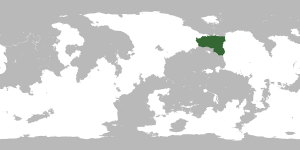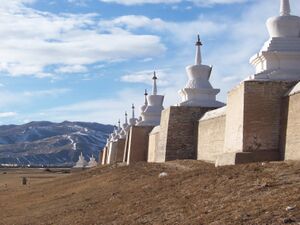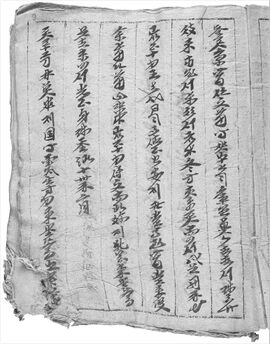Tergynia
Democratic Republic of Tergynia ᡋᡇᡎᡑᡉ ᠨᠠᡅᠷᠠᡏᡑᠠᡍᡇ ᠠᠷᠠᡑᡒᡅᠯᠰᠠᠨ ᡐᡄᠷᡎᡄᠨ ᡎᡈᠷ | |
|---|---|
Motto: Our Eternal Blue Sky | |
Anthem: ᡋᡉᡎᡑᡉ ᠨᠠᡅᠷᠠᡏᡑᠠᡍᡇ ᠠᠷᠠᡑᡒᡅᠯᠰᠠᠨ ᡐᡄᠷᡎᡄᠨ ᡎᡉᠷᡄᠨ ᡐᡈᠷᡅᠨ ᡑᠠᡎᡇᠯᠠᠯ ("National Anthem of the Democratic Republic of Tergynia") Flag anthem: ᡋᡉᡎᡑᡉ ᠨᠠᡅᠷᠠᡏᡑᠠᡍᡇ ᠠᠷᠠᡑᡒᡅᠯᠰᠠᠨ ᡐᡄᠷᡎᡄᠨ ᡎᡉᠷᡄᠨ ᡐᡇᡎᡅᠨ ᡑᠠᡎᡇᠯᠠᠯ ("Flag Anthem of the Democratic Republic of Tergynia)" | |
 Land controlled by the Republic of Tergynia shown in green | |
| Capital | Daudbalgas |
| Largest city | Holjinhar |
| Official languages | Standard Tergynian |
| Recognised regional languages | |
| Official script | Clear script |
| Ethnic groups | |
| Religion (2021) |
|
| Demonym(s) | Tergynian |
| Government | Unitary semi-presidential republic |
| Abohon Muŋhgerel | |
| Tsaraagiin Ishaš | |
| Haidolon Tsaur | |
| Legislature | State Great Hural |
| Formation | |
| 1971 | |
| Area | |
• Total | 0 km2 (0 sq mi) (?) |
• Water (%) | 100 |
| Population | |
• 2021 estimate | |
• 2021 census | 25,385,000 (?) |
• Density | 65.3/km2 (169.1/sq mi) (?) |
| GDP (nominal) | 2021 estimate |
• Total | |
• Per capita | |
| Gini (2021) | medium |
| HDI (2019) | high · ? |
| Currency | Tugrug (⊼) (TRT-Tugrug)) |
| Time zone | UTC+8 (Tergynian Standard Time) |
| Date format | Template:Vunblist |
| Driving side | right |
| Calling code | +88 |
| Internet TLD | |
Tergynia, officially the Democratic Republic of Tergynia (DRT), is a country in Cancodia. It is bordered to the north by Omniabstracta, to the east by the Meridan Sea, to the south by Lanhuanan, and to the west by the Nuntic Ocean. The capital city is Daudbalgas and the largest city and historic capital is Chichihari. Tergynia is a pluralistic society with its 25 million people comprising of various ethnolinguistic groups, the largest among these being the Tergyn people followed by significant minorities of Otoghuz and Aicuns. Tergynia is 76% Manichaean, with the remainder being irreligious, adhere to a form of Tengrism, or follow other faiths.
The first recorded settled civilizations in Tergynia were the Āṣṇi and the Nayati that established city states and kingdoms along the western coast. Central and northern Tergynia was home to various nomadic groups including the proto-Tergyns, Rimians, and Aicunic peoples. The eastern coast was inhabited by seafaring Songgyi and Bo'ku societies that lasted until the 1100s. Tergyn steppe nomads and Manichaean Otoghuz nomads from Central Cancodia conquered the mostly sedentary societies along the coasts and formed various steppe empires, such as the Särpi, Nirun, and Otoghuz. In the 1100s, Horbun Gurkhan established the Tergyn Empire that spanned from West Tergynia to Faulknia. The Tergynian revolution in 1933, which overthrew the Tergyn Khaganate, established a multi-party democracy.
Etymology
Template:Infobox Chinese The ethnonym "Tergen" means "people of the carts". The name "Tergynia" in its current form was first attested by Serrian merchants in the 12th century. The medieval Serrian term "Tergyn" is derived from the Old Otoghuz term "Tergin", which was ultimately loaned from the Tergyns' original ethnonym.
History
Prehistory
The proto-Rimians began migrating into the Tergyn Steppe by around 3000 BCE. The proto-Songgyi settled along the eastern coast around 2300 BCE. Scythic peoples moved into Western Tergynia by 1900 BCE. By around 1300 BCE, proto-Tergynic cultures began to form.
Antiquity
The Āṣṇi and Nayati tribes established a network of city states and kingdoms along Tergynia's western coast that interacted with various civilizations in the Nuntic sea. On the eastern coast, some Bo'ku and Songgyi peoples established sea-faring societies. In between the seas, proto-Tergynic peoples and Rimians lived together on the steppe, until the Rimians were driven from the steppe and into the mountains. In 200 BC, one of the only remaining Bo'ku steppe pastoralists established the Bo'ku steppe confederacy, which laid the foundations for a string of nomadic empires to occupy central and eastern Tergynia.
Middle Ages
By the 300s, the Āṣṇi and Nayati kingdoms were in decline due to constant warfare, conflict with nomadic groups, and climate change. The first instance of Qijaric migration into the territory of Tergynia was around 400 when Šuroghur tribes migrated into southwestern Tergynia. In the 800s, various Manichaean Qijaric tribes fled central Cancodia after being forced out by other Qijaric tribes and reorganized themselves into the Otoghuz Confederation in southwestern Tergynia. The Otoghuz absorbed the Xuroghur and conquered the declining Nayati and Āṣṇi kingdoms.
Tergyn Empire
In 1120, the Tergyn Empire was founded by Horbun Gurkhan. The Tergyns conquered the Otoghuz states around 1126 and Omniabstracta by 1132. Horbun Gurkhan passed away in 1133, with Chara, Horbun's first son, being elected Gurkhan by the Huraldai in the same year. In 1135, the Tergyns began their conquest of Southern Barkadia led by Nyiqo Noyan, the second son of Horbun Gurkhan. After the death of Chara Gurkhan in 1183, his son Khuju became Gurkhan. Nyiqo Noyan founded the Nyiqo Ulus in Southern Barkadia as a semi-independent polity of the gurkhanate. After Nyiqo Noyan's death in 1200, the Nyiqo Ulus was split between the Sarhan Ulus in the north, lead by the descendants of Sarhan Noyan, and the Sauqu Ordu in the east, led by Chara's adopted Otghuz son Bohoris. in 1296, the Sarhan Ulus fell to Barkadian chiefdoms. By 1300, the Sauqu Ordu was running de-facto independently from the Great Gurkhanate. By 1441, the remnants of the Sauqu Ordu were conquered by Barkadian and Kolonian chiefdoms. The Tergyns lost control of Omnic lands in the 1500s.
Post-empire
placeholder
Tergyn Khaganate
In 1583, Ormus Khagan of the Merged Hayad united the Tergyn tümens once more and founded the Tergyn Khaganate. Ormus' Toganjin clan was Ondaq in origin, but had adopted Merged customs.
Tavantömör, son of Ölziit Khagan, was fascinated by the culture and structure of the civilizations of Tergynia's southern neighbours. This fascination fueled his ambition to reform the Tergyn Khaganate into a centralized, settled empire. When Tavantömör was elected by the huraldai to be khagan in 1668, he started a series of reforms to establish permanent settlements throughout the khaganate and encouraged settled tribes to take up agriculture. Tavantömör hired skilled advisors from Lanhuanan to plan cities, establish codified laws, found universities, and to introduce agriculture to the settlements. Due to several disastrous zuds that killed many tribes' livestock, several tribes moved into the settlements and took up agriculture. Initially, Tavantömör was hesitant about forcing unwilling tribes to settle, however when the Merged raided the settlement of Böh, Tavantömör issued a decree to forcefully settle the Merged and all remaining fully-nomadic tribes. This ignited a 10 year civil war that saw nearly half of the noyons take up arms against the khagan. The rebelling tribes managed to win the siege of Chichihari and forced the Khagan and his allies to retreat to the city of Hardalai on the Nuntic coast. The rebelling armies sieged Hardalai, but due to fresh reinforcements, better fortifications, and firearms from the southern nations, the rebels were forced to retreat to their camps. Tavantömör lead his army to engage the demoralized rebels and completely decimated them. All of the rebelling noyons were executed by horses trampling on them. Tavantömör, with the support of his reformist allies, abolished the huraldai system, which was the start of the absolutist rule of his dynasty. He exiled most of the remaining fully-nomadic tribes into the northern mountains, where they still remain. Tribes that practiced transhumance were treated with great leniency.
Modern History
Fall of the Khaganate
By the early 1900s, Bayan Khagan's anti-foreign protectionist policies were in full swing.
Republic of Tergynia
The Republic of Tergynia was proclaimed in 1935 after the abdication of the Khagan.
Dictatorship
In 1959, President Dayano Sahla launched a self-coup in order to establish absolute rule over Tergynia. His rule is described by historians as a paternalistic personalist dictatorship.
Democratic Republic of Tergynia
On July 6, 1971, the National Security Council stepped down and allowed the establishment of the Democratic Republic of Tergynia.
Geography
Landscape and climate
Biodiversity
Environment
Political geography
Politics
Government
Administrative divisions
Foreign relations
Trade relations
Sociopolitical issues and human rights
Military
Economy
Wealth in Tergynia
Economic growth
Tergynia in the global economy
Class and income inequality
Science and technology
Historical
Modern era
Infrastructure
Telecommunications
Transport
Water supply and sanitation
Demographics
Ethnic groups
Languages
Standard Tergyn is the standardized literary language used by the Tergynian government and media. It is descended from the court language of the Tergyn Khaganate, which was a hybrid of the Chichihari dialect of Middle Merged and Middle Tergyn. Language reforms in the Republican era introduced more native Tergyn words into the vocabulary in order to better represent the vernacular language of the Eastern Tergynians. Vernacular Eastern Tergyn is not as influenced by Merged as the standard language is.
Urbanization
Template:Most populous cities in the Democratic Republic of Tergynia
Education
Health
Religion
The majority religion in Tergynia is Manichaeism with 76% of Tergynian being adherants. Ortakend in Western Tergynia is the seat of the Yamag of the Manichaean Church, otherwise known as the Aspasag of Ortakend. The current Tamag of the Manichaean Church is Mihr VIII.
Traditional Tengrism is still practiced in Kosoo Dawa and Üčsümer. Neo-Tengrism originated in urban areas in the 20th century as a form of counterculture. Today, political Neo-Tengrism has been adopted by several politicians, including Prime Minister Ishaš.
Culture

Tourism in Tergynia
Literature

Philosophy
Cuisine
Music
Cinema
Fashion
Sports
Boikoo tarkbei and poolie tarkbei are considered to be national sports of Tergynia.



